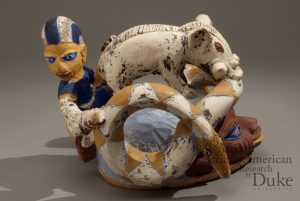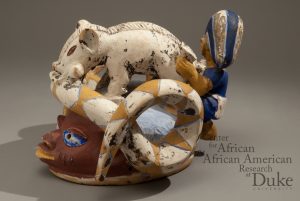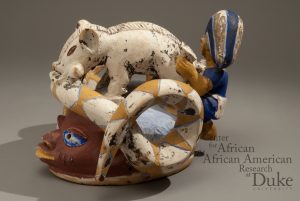

The Spirited Things exhibit in the Fleming Museum is a lively display of altars and artworks from various Caribbean religions. The exhibit is erupting with color, wonder, magic, history, and life. Each piece was curiously unfamiliar to me, some more than others. It was difficult to identify the piece I was most interested in–there were dangling tassels, glittery fabrics, and bright colors at every turn. I was drawn to the Gelede Mask because of it’s quiet, powerful appearance. It contrasted with other objects in the exhibit in that it was not decorated in a particularly eye-catching way–it was composed of primarily earth tones, and its display was simple and uncomplicated. It was standing alone in a minimalistic glass case, located in a section of the museum dedicated to items related to gender–a topic I take a special interest in. The mask displays a woman’s face, decorated with a snake wrapped around her head, and a warthog and hunter on the back side. This first section of this essay will discuss and raise questions about the gender dynamics within the history of the Gelede mask–while the second section will explore the implications of African art, such as the mask, on display in Western museums, and the limited possibility of translation of meaning between these two cultures.
The gender dynamics at play in the Gelede ritual illustrate the limited, yet paramount role of women in Yoruba rituals. The Gelede mask was created in July of 1983 for use within the Gelede festival in Nigeria–a spectacular ritual that pays homage to the spiritual powers of women. The powers possessed by such women are believed to influence the flow of good and bad events in practitioners’ lives, and can be used for the benefit/destruction of society. These powers are comparable to those of gods, spirits, and ancient ancestors of Yoruba peoples. Women (usually elders) who use their spiritual powers for destructive purposes are deemed witches in Yoruba culture. The Gelede ritual’s aim is to influence the witches to use their powers for good versus evil. Interestingly, men perform this ritual wearing masks that depict the faces of beautiful women, and extravagant dresses and skirts to complete the imitation and performance. In a ritual dedicated to women and their power over society, only men are allowed to participate. Women observe from the sidelines of the ritual, watching and judging the men’s imitation of their own gender. In Men Portraying Women: Representations in African Masks, an article by Elisabeth Cameron, professor of history, art, and visual culture at the University of California Santa Cruz, the woman’s take on the Gelede ritual is perfectly captured:
The mask itself, then, is not the only element in these portrayals: in performance the male dancer imitates the movements of a woman. The young girls and women watch these embodiments of the feminine ideal, understanding that the conduct of the masquerade is what men desire of them. As Manuel Jordan suggests, however, “Women are willing to accept the female model presented to them by men if they agree that it represents them appropriately (Cameron 1998, 72).
Cameron provides helpful insights into the woman’s perspective of the Gelede festival. In a ritual dedicated to the worship of women, not being able to perform it themselves must raise questions as to what the woman’s role in Yoruba ritual really is. Instead of participating, women observe the embodiments of the feminine ideal, as Cameron states, and agree to accept this uneven distribution of power within the ritual if the men’s representation of them seems accurate and fair. Is it not strangely hypocritical to celebrate the power and importance of women within society, without including them in the process? The design of the mask brings about similar questions–the mask depicts a hunter on the back of the woman’s head, as if he was controlling her. The hunter’s placement brings about some questions related to gender relations both in Yoruba culture and in the Gelede festival. Does the hunter also convey the idea that men are ultimately in control of these traditions? If the powers of women are as feared and worshiped as the Gelede ritual ritual suggests, it seems risky to exclude women from such important practices that could affect the wellbeing of Yoruba society as a whole. As seen in the photos attached, this mask is a beautiful and culturally charged piece of artwork–but the Gelede mask also functions as a spiritual altar, due to its use in ritual practice.
Spiritual altars in Yoruba cultures provide ways to call spirits, ancestors, gods, or other symbolic beings (such as witches) to a specific place. Altars are often adorned with beautiful decorations and offerings to various orisha (gods). Most often, altars are long tables or displays full of spiritual objects and vessels, some containing the essence of different orisha. The Gelede mask on display in the Fleming museum does not appear to be an altar in the traditional sense of the word–however, the Gelede mask functions as an active spiritual altar among Yoruba people who practice Gelede tradition. It’s purpose is, indeed, to call upon spirits of witches and attempt to guide or influence what they use their powers for. This type of altar is different than a traditional table altar, in that it is actively used in rituals rather than observed and simply used as a place to leave offerings and extend worship to the different orisha. The Gelede mask can be described as art with a purpose.
All African art is created with the idea that it must have a source of life to hold meaning. In Professor Rowland Abiodun’s book, Yoruba Art and Language: Seeking the African in African Art, he discusses the idea that artworks in Africa need to be ”activated” by some form of energy or life in order for the art to reach its full potential, along with the doubt and skepticism that Westerns have shown towards this idea. Such is the case with the Gelede mask: until it is activated by using it in symbolic rituals, the mask does not hold nearly as much meaning as it would after it’s been infused with life and energy from the Gelede festival. This source of life is called așe, and is used throughout Yoruba culture to describe the life force that is within people, artwork, animals, etc. This idea of aşe does not lend itself easily to straightforward description, translation, and analysis using Western terminologies present in the humanities (Abiodun 2014, 56). Aşe is not something that we, in the West, use to classify and qualify objects and people–however, in Yoruba culture, aşe describes a desirable force that, if present in a person or object, gives divine meaning and essence to said person/object. As the Gelede mask is used and therefore activated in the Gelede festival, its aşe increases as practitioners “breathe” life into the mask by using it in such a way that infuses it with energy from the spirits and witches it calls upon.
It is this concept of așe that creates a cloudy barrier between African art and the Western understanding of it. Abiodun states in his book that “African art was not even considered art with a capital “A” until relatively recent times, mainly because art was defined entirely by modernist Western scholars for whom art was ‘for art’s sake’” (Abiodun 2014, 2). In the West, the idea of așe simply does not exist. As Abiodun stated, art is created “for art’s sake,” with no such energy requirement as așe. This divide between the fundamental ideas of art causes me to wonder if the paramount gender conceptions present in Yoruba cultures that are represented by this mask can be translated in a way that will make sense to Westerners not familiar with the idea of așe. In Yoruba scholar Babatunde Lawal’s book, The Gẹ̀lẹ̀dé Spectacle : Art, Gender, and Social Harmony in an African Culture, the necessity of așe in African art is discussed: “. . . the human image, a masterpiece by Obatala, embodies a special power (așe), inspiring and sustaining the creativity manifest in the visual, performing, and applied arts . . .” (Lawal 1996, 24). Lawal’s comments can be analyzed to infer that it is necessary to maintain the așe in the Gelede mask in order to preserve and translate the conceptions of women’s roles in ritual practice within the Gelede tradition.
The așe of the Gelede mask is vital to the understanding of the tradition itself, along with the complex gender dynamics involved. However, one must question whether așe is now present in the mask at all, as it is currently on display in a glass case in the Fleming museum instead of being used in ritual practice. I believe that the Gelede mask is one of the most interesting items in the Spirited Things exhibit–it carries such complex connotations and ideas related to gender and the dynamics involved in the Gelede festival. It delves into the way women are perceived by both themselves and men, as depicted in the Gelede festival. but unfortunately, I believe that a lot of that is lost without the aşe normally present in the mask. The Gelede mask is a physical representation of the idea that African art must be alive in some way in order to reveal its purpose. This mask, and exhibit as a whole, demonstrates that African art is not created to simply sit in a case and be observed–although in the West, this is the first step to introducing such concepts as aşe to the art world. I believe the lack of understanding of aşe is why Western scholars took/are taking such a long time to validate African art. The idea that art isn’t meant to be still or on display is unfamiliar to these scholars, and unfamiliarity, in many cases, precedes dissent.
Bibliography
Abiodun. Yoruba Art and Language: Seeking the African in African Art. Cambridge University Press, 2014.
Cameron, Elisabeth L. “Men Portraying Women: Representations in African Masks.” African Arts 31, no. 2 (1998): 72-94. doi:10.2307/3337523.
Lawal, Babatunde. The Gẹ̀lẹ̀dé Spectacle : Art, Gender, and Social Harmony in an African Culture / Babatunde Lawal. Seattle: University of Washington Press, 1996.


